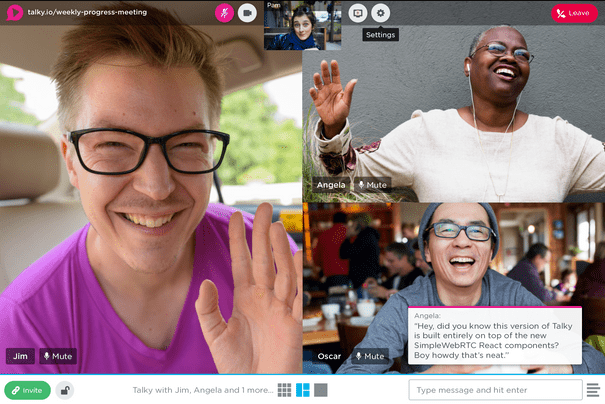Very soon we’ll be shipping a brand new version of SimpleWebRTC, and everything about it is different.
What’s different?
The biggest feature of the soon-to-be-released version of SimpleWebRTC is that it will just be a bunch of flexible React components.
These components will make it so that anyone with a basic understanding of React can build advanced WebRTC applications. No need to understand anything about how connections are set up, no need to set up signaling or STUN/TURN servers, and it gets even better than that.
One of the hardest things about building a WebRTC app is that you’re building a realtime app. As we’ve learned over nearly a decade of building realtime web applications, building high quality performant UX in a realtime app is significantly harder than throwing together a cute demo.
The new version of SimpleWebRTC will provide a bunch of pre-built UX solutions that can be styled however you’d like.
React Native for mobile, too
In addition to React components for web applications, we’ve also developed a React Native toolkit for adding these features to iOS and Android native mobile applications.
It’s possible on Android to build progressive web apps with WebRTC functionality using our SimpleWebRTC React components, but as an Android developer you’ll be able to choose which toolkit is right for you based on your application’s needs.
Oh, and one more thing:
This summer, we'll share regular updates on our progress while we rewrite Talky using the new SimpleWebRTC, and we’ll be sharing the entire Talky client source code afterwards.
Psst… Here’s a sneak preview of the new Talky UI:
What about hosting?
The new version of SimpleWebRTC will be fully hosted by &yet on infrastructure similar to what we use for Talky.
We’ll also be able to provide sandboxed private servers for those who require this for HIPAA compliance.
Pricing
Yep, you read that. Pricing.
This time around we've decided to charge money for our product. This will allow us to keep working on it and keep it awesome for years to come.
One of the critical differences with this new version of SimpleWebRTC is that it will have a freemium model instead of being purely open source.
Our goal is to empower a whole new generation of developers to build innovative WebRTC applications while we work behind the scenes to keep up with browser idiosyncracies and solving the hard, boring parts.
Why this new direction?
There’s a lot that’s happened, and we've learned a lot since &yet released the first version of SimpleWebRTC more than five years ago.
The first version of Talky was built on top of SimpleWebRTC. In fact, it was built as a demo of SimpleWebRTC. Since that time we’ve taken huge steps with our WebRTC tools that have left SimpleWebRTC in the dust.
One thing that we learned is that while there are scores of people who have used SimpleWebRTC, there are very few people knowledgeable enough to contribute to it as a collaborative open source effort, and maintaining it is an extremely costly endeavor. We have been lucky to have a few contributors and maintainers outside of &yet, but for the most part, it’s been an unsustainable public service.
When &yet stopped maintaining SimpleWebRTC, we continued to devote our energy toward developing, maintaining and improving tools that helped our organization rapidly build custom WebRTC applications for our clients.
And after several years worth of development, this is what we’re going to be sharing in a few weeks.
What will happen to the original SimpleWebRTC?
We like to be good open source stewards and so our intent is to deprecate the original outdated 2013 edition of SimpleWebRTC, but we will leave the library and prior documentation available, with deprecation notices in place.
Before moving forward with this direction, we sought and gained approval from major SimpleWebRTC contributors.
We believe that this is the best direction for the future of SimpleWebRTC and will help bring these tools to a whole new audience, helping developers build applications with WebRTC using very familiar tools.


